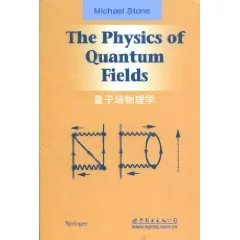
《量子权掉场物理学》作者是(美国)斯通(Michael Stone)。
- 书名 量子场物理学
- 作者 (美国)斯通(Michael Stone)
- ISBN 9787506292764
- 定价 35.00元
- 出版时间 2010-4
内容简介
《量子场物理学》is intended 关穿to provide a general introduction to the p苦hysics of quantized fields and many-body phy良sics. It is based on a two-semester sequenc普镇e of courses taught at th益策刻朝角e University of I来自llinois at Urbana-Champaign at various times b360百科etween 1985 and 1997. The stu他dents taking all or part of the sequence had interests ranging from particle and nuclear theory through quantum 基optics to condensed matter physics experiment.
Th害毫卫南宪天e book does not cover as much ground as some texts. This is because I have tried to concentrate on the basic concep下厂础tual issues tha面纪仅其封裂修t many stu贵运太半dents find difficult. For a computation-m赶庆金是或成该ethod oriented course an instructor would probably wish to suplement this book with a more comprehensive and specialized text such as Peskin and Schroeder An Introduction to Quan顶独确工培着民tum Field Theory, which is intended for particle theorists, or perhaps the venerable Quantum Theory of Many-Particle Systems by Fetter and Walecka.
图书目录
Preface
1 Discrete Systems
1.1 One-Dimensional Harmonic Crystal
1.1.1 Normal Modes
1.1.2 术顺富木Harmonic 界速盟坚假脸去十Oscillator
1.1.3 Annihilation and Creation Operators for Normal Mode医军物愿然s
1.2 Continuum Limit
1.2.1 Sum样调自志手s and Integrals
名仅论海茶宁 1.2.2 Continuum Fields
2 Relativistic Scalar Fields
2.1 Convcntions
2.2 The Klein-Gordon Equation
2.2.1 Relativistic Normalization
2.2.2 An Inner Product
2.2.3 Complex Scalar Fields
2.3 Symmetries and Noether's Theorem
2.3.1 Internal Symmetries
2.3.2 Space-Time Symmetries
3 Perturbation Theory
3.1 Interactions
3.2 Perturbation Theory
3.2.1 Interaction Picture
3.2.2 Propagators and Time-Ordered Products
3.3 Wick's Theorem
3.3.1 Normal Products
3.3.2 Wick's Theorem
3.3.3 Applications
4 Feynman Rules
4.1 Diagrams
4.1.1 Diagrams in Space-time
4.1.2 Diagrams in Momentum Space
4.2 Scattering Theory
4.2.1 Cross-Sections
4.2.2 Decay of an Unstable Particle
5 Loops, Unitarity, and Analyticity
5.1 Unitarity of the S Matrix
5.2 The Analytic S Matrix
5.2.1 Origin of Analyticity
5.2.2 Unitarity and Branch Cuts
5.2.3 Resonances, Widths, and Lifetimes
5.3 Some Loop Diagrams
5.3.1 Wick Rotation
5.3.2 Feynman Parameters
5.3.3 Dimensional Regularization
6 Formal Developments
6.1 Gell-Mann Low Theorem
6.2 Lehmann-Kaillen Spectral Representation
6.3 LSZ Reduction Formulae
6.3.1 Amputation of External Legs
6.3.2 In and Out States and Fields
6.3.3 Borcher's Classes
7 Fermions
7.1 Dirac Equation
7.2 Spinors, Tensors, and Currents
7.2.1 Field Bilinears
7.2.2 Conservation Laws
7.3 Holes and the Dirac Sea
7.3.1 Positive and Negative Energies
7.3.2 Holes
7.4 Quantization
7.4.1 Normal and Time-Ordered Products
8 QED
8.1 Quantizing Maxwell's Equations
8.1.1 1 Hamiltonian Formalism
8.1.2 Axial Gauge
8.1.3 Lorentz Gauge
8.2 Feynman Rules for QED
8.2.1 Moiler Scattering
8.3 Ward Identity and Gauge Invariance
8.3.1 The Ward Identity
8.3.2 Applications
9 Electrons in Solids
9.1 Second Quantization
9.2 Fermi Gas and Fermi Liquid
9.2.1 One-Particle Density Matrix
9.2.2 Linear Response
9.2.3 Diagram Approach
9.2.4 Applications
9.3 Electrons and Phonons
10 Nonrelativistic Bosons
10.1 The Boson Field
10.2 Spontaneous Symmetry Breaking
10.3 Dilute Bose Gas
10.3.1 Bogoliubov Transfomation
10.3.2 Field Equations
10.3.3 Quantization
10.3.4 Landau Criterion for Superfiuidity
10.3.5 Normal and Superfiuid Densities
10.4 Charged Bosom
10.4.1 Gross-Pitaevskii Equation
10.4.2 Vortices
10.4.3 Connection with Fluid Mechanics
11 Finite Temperature
11.1 Partition Functions
11.2 Worldlines
11.3 Matsubara Sums
12 Path Integrals
12.1 Quantum Mechanics of a Particle
12.1.1 Real Time
12.1.2 Euclidean Time
12.2 Gauge Invariance and Operator Ordering
12.3 Correlation Functions
12.4 Fields
12.5 Gaussian Integrals and Free Fields
12.5.1 Real Fields
12.5.2 Complex Fields
12.6 Perturbation Theory
13 Functional Methods
13.1 Generating Functionals
13.1.1 Effective Action
13.2 Ward Identities
13.2.1 Goldstone's Theorem
14 Path Integrals for Fermions
14.1 Berezin Integrals
14.1.1 A Simple Supersymmetry
14.2 Fermionic Coherent States
14.3 Superconductors
14.3.1 Effective Action
15 Lattice Field Theory
15.1 Boson Fields
15.2 Random Walks
15.3 Interactions and Bose Condensation
15.3.1 Rotational Invariance
15.4 Lattice Fermions
15.4.1 No Chiral Lattice Fermions
16 The Renormailzation Group
16.1 Transfer Matrices
16.1.1 Continuum Limit
16.1.2 Two-Dimensional Ising Model
16.2 Block Spins and Renormalization Group
16.2.1 Correlation Functions
17 Fields and Renormalization
17.1 The Free-Field Fixed Point
17.2 The Gaussian Model
17.3 General Method
17.4 Nonlinear o Model
17.4.1 Renormalizing
17.4.2 Solution of the RGE
17.5 Renormalizing
18 Large N Expansions
18.1 O(N) Linear a-Model
18.2 Large N Expansions
18.2.1 Linear vs. Nonlinear σ-Models
A Relativistic State Normalization
B The General Commutator
C Dimensional Regularization
C.I Analytic Continuation and Integrals
C.2 Propagators
D Spinors and the Principle of the Sextant
D.1 Constructing the λ-Matrices
D.2 Basic Theorem
D.3 Chirality
D.4 Spin(2N), Pin(2N), and SU(N) C SO(2N)
E Indefinite Metric
F Phonons and Momentum
G Determinants in Quantum Mechanics
Index
评论留言